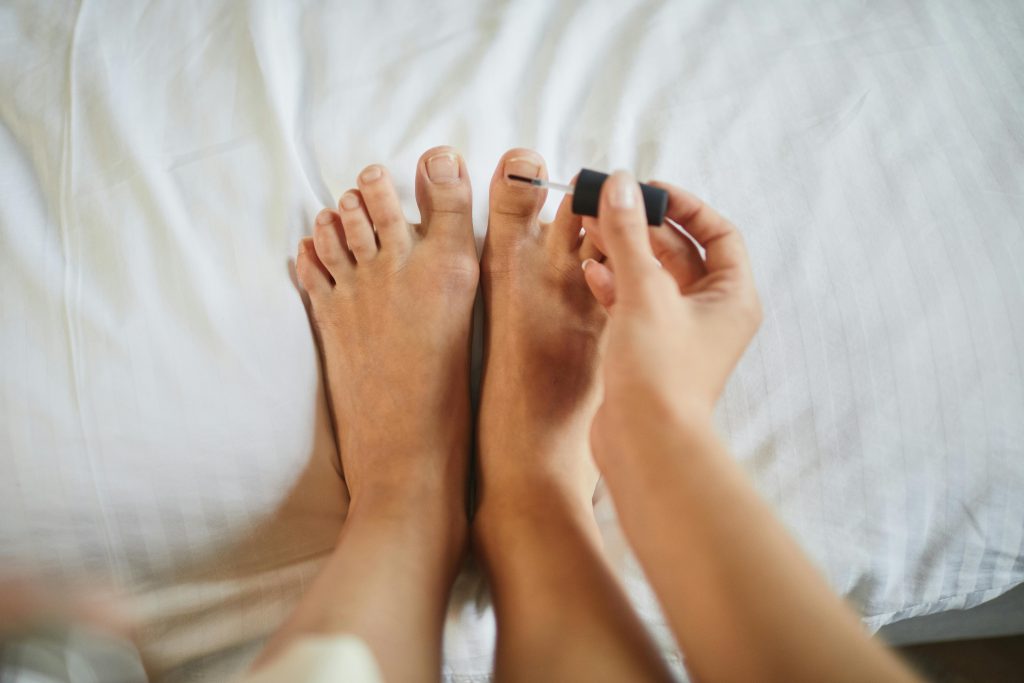Nail fungal infections, known as onychomycosis, are more common than you might think. These infections can be stubborn and unsightly, often causing embarrassment and discomfort. Understanding the high-risk situations that can lead to nail fungus and knowing how to effectively treat it is essential for maintaining healthy, happy feet. In this comprehensive guide, we’ll explore what causes nail fungus and discuss effective treatment options.
What Causes Nail Fungus?
Nail fungal infections are primarily caused by dermatophytes, a group of fungi known for infecting skin, hair, and nails. The following factors can contribute to the development of onychomycosis:
- Warm and Humid Environments: Fungi thrive in warm and moist environments, making communal areas like public showers, locker rooms, and swimming pools prime locations for contracting nail fungus. Walking barefoot in these areas increases the risk of exposure.
- Trauma to the Nails: Injuries or trauma to the nails, such as a stubbed toe, can create an entry point for fungi. Damage to the nail provides an opportunity for fungi to invade and establish an infection.
- Poor Foot Hygiene: Neglecting proper foot hygiene, such as not drying the feet thoroughly after bathing or wearing sweaty or damp shoes and socks, can create conditions favourable for fungal growth.
- Weakened Immune System: Individuals with weakened immune systems, like those with diabetes or HIV, are more susceptible to fungal infections, including nail fungus. Their bodies may struggle to fight off the invading fungi effectively.
- Age and Genetics: As we age, our nails tend to become more brittle and prone to infections. Genetics also play a role, as susceptibility to fungal infections can be hereditary.
High-Risk Situations for Nail Fungal Infections
- Public Swimming Pools and Showers: Walking barefoot in public showers and swimming pool areas is a common way to pick up the fungus. To reduce your risk, wear flip-flops or water shoes in these environments, and make sure to thoroughly dry your feet after exposure.
- Sharing Personal Items: Sharing shoes, socks, nail clippers, or pedicure equipment with someone who has a fungal infection can lead to the spread of the fungus. It’s important to avoid sharing personal items and maintain proper foot hygiene.
- Nail Salons: Nail salons can be high-risk environments for nail fungal infections, especially if they do not adhere to strict hygiene and sanitation practices. Make sure to choose a reputable salon that follows proper disinfection procedures.
- Wearing Tight or Non-Breathable Shoes: Shoes that do not allow proper ventilation can create a warm, damp environment, perfect for fungal growth. Choose breathable shoes and moisture-wicking socks to help prevent nail fungus.
- Neglecting Nail Care: Not properly caring for your nails, like keeping them too long or not trimming them straight across, can increase the risk of nail fungal infections. Maintain good nail hygiene to reduce the risk.
How to Treat Nail Fungus
Treating nail fungus can be challenging, but several effective options are available:
- Over-the-Counter (OTC) Antifungal Products: OTC topical antifungal or nail polishes can be effective for mild cases of nail fungus. These products typically contain active ingredients such as amorolfine or ciclopirox.
- Prescription Medications: For more severe infections, your healthcare provider may prescribe oral antifungal medications.
- Laser Therapy: Laser therapy is a relatively new treatment option that uses laser light to penetrate the nail and destroy the fungi. While it can be effective, it may require multiple sessions and can be costly.
- Surgical Removal: In severe cases, surgical removal of the infected nail may be necessary to allow topical or oral treatments to reach the underlying infection.
Step Towards Healthy Toes
Nail fungal infections can be persistent and frustrating, but understanding the risk factors and causes is the first step in preventing and treating them. By avoiding high-risk situations, maintaining good foot hygiene, and promptly addressing any signs of infection, you can reduce the likelihood of developing nail fungus.
If you do find yourself facing a nail fungal infection, a variety of treatment options are available, ranging from OTC remedies to prescription medications and even laser therapy. It is essential and recommended to consult a healthcare provider for a proper diagnosis and to discuss the most suitable treatment plan based on the severity of the infection. With diligence and the right approach, you can successfully treat nail fungal infections and regain healthy, happy feet.


